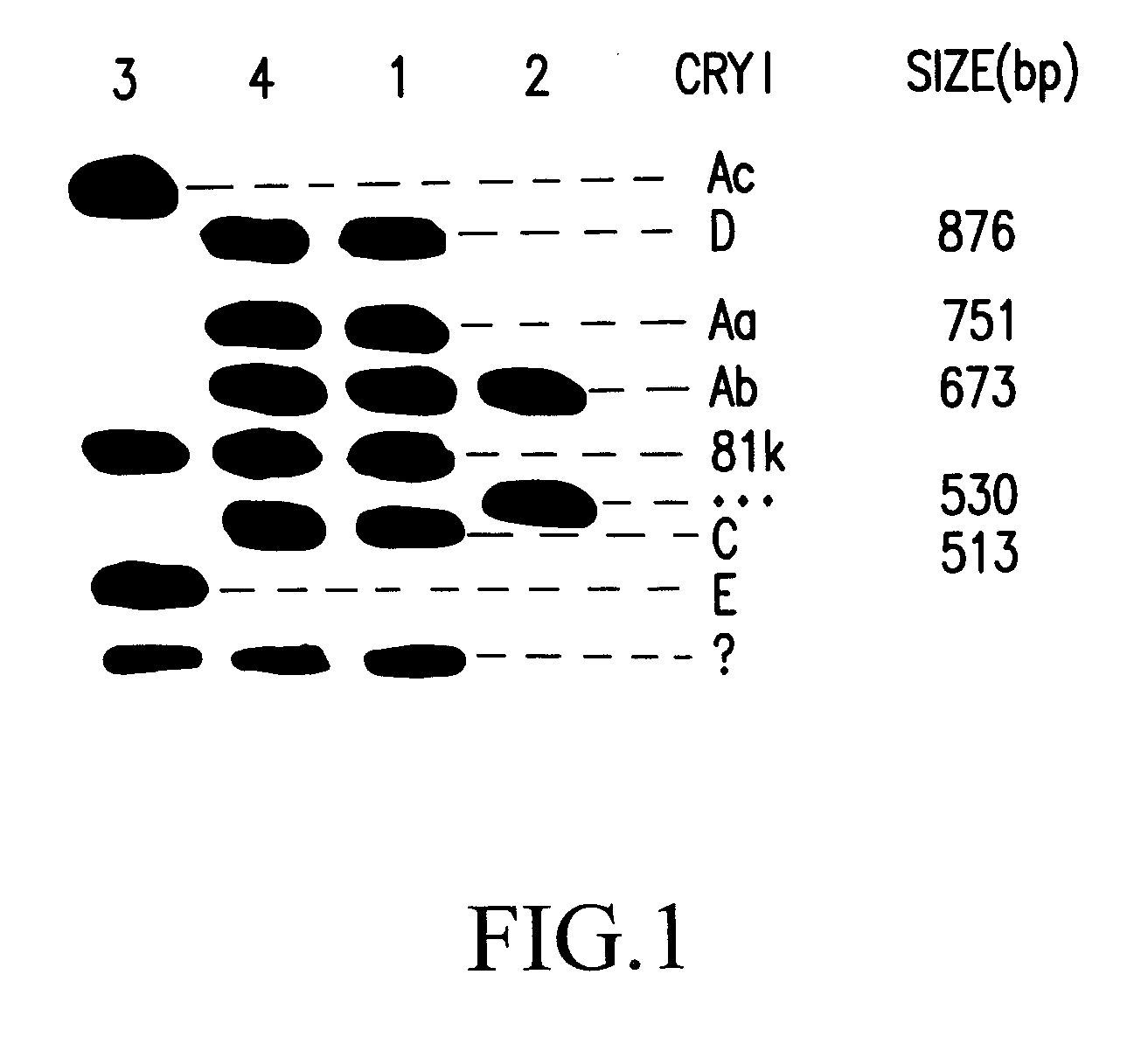Bacillus thuringiensis strains and their insecticidal proteins
a technology of insecticidal proteins and strains, applied in the field of bacillus thuringiensis strains and their insecticidal proteins, can solve the problem of difficult process of obtaining the expression of such bt gene fragments in plants
- Summary
- Abstract
- Description
- Claims
- Application Information
AI Technical Summary
Benefits of technology
Problems solved by technology
Method used
Image
Examples
example 1
Characterization of the BTS02617A, BTS02618A, BTS02654B and BTS02652E Strains
[0054] The BTS02617A, the BTS02618A and the BTS02654B strain were isolated from grain dust sampled in Cadlan, province of Bicol, The Philippines and were deposited at the BCCM-LMG on Jul. 2, 1992 under accession Nos. LMG P-12592, LMG P-12593 and LMG P-12594, respectively. Strain BTS02652E was also isolated from Philippine grain dust, and was deposited at the BCCM-LMG on March, 1, 1993 under accession No. LMG P-13493.
[0055] Each strain can be cultivated on conventional standard media, preferably T3 medium (tryptone 3 g / l, tryptose 2 g / l, yeast extract 1.5 g / l, 5 mg MnCl2, 0.05 M Na2PO4, pH 6.8 and 1.5% agar), preferably at 28° C. For long term storage, it is preferred to mix an equal volume of a spore-crystal suspension with an equal volume of 50% glycerol and store this at −70° C. or lyophilize a spore-crystal suspension. For sporulation, growth on T3 medium is preferred for 48 hours at 28° C., followed b...
example 2
Insecticidal Activity of the BTS02617A. BTS02618A BTS02654B and BTS02652E Strains and the BTS02618A Protoxin Against Noctuidae spp. Yvonomeutidae spp. and Pyralidae spp.
[0059] Toxicity assays were performed on neonate larvae (for Plutella xylostella, third instar larvae were used) fed on an artificial diet layered with spore-crystal mixtures from one of the BTS02617A, BTS02618A, BTS02654B and BTS02652E strains or the BTS02618A protoxin or toxin. The artificial diet was dispensed in wells of Costar 24-well plates. Formaldehyde was omitted from the diet. 50 μl of a sample dilution was applied on the surface of the diet and dried in a laminar air flow. For LC50 assays, the dilutions were made in a PBS-BSA buffer, and five dilutions were applied. Two larvae were placed in each well and 24 larvae were used per sample dilution. Dead and living M. brassica, S. frugiperda, H. virescens, O. nubilalis, Plutella xylostella and S. exigua larvae were counted on the fifth day, and dead and livin...
example 3
Identification of the bTS02618A Gene
[0068] The bTS02618A gene was identified in the BTS02618A strain by Southern blot analysis (FIG. 1) of AluI digested total DNA of the strain using, as a DNA probe, the DNA sequence of the cryIG gene (Gleave et al., 1992) of SEQ ID No. 1 and using standard hybridization conditions. Partial DNA sequences of the bTS02618A gene, showing its 5′ and 3′ end portions, are shown in SEQ ID Nos. 2 and 3, respectively, and the full DNA sequence of the bTS02618A gene and the full amino acid sequence of the BTS02618A protein are shown in SEQ ID No. 4.
[0069] The partial sequences of SEQ ID Nos. 2 and 3 allow the bTS02618A gene to be recognized in the BTS02617A, BTS02654B and BTS02652E strains and allow the construction of probes to identify and isolate the full gene sequence in these and other Bt strains. The translation initiation codon of the bTS02618A gene is identified at nucleotide position 195-197 in SEQ ID No. 2, corresponding to nucleotide position 668...
PUM
| Property | Measurement | Unit |
|---|---|---|
| Fraction | aaaaa | aaaaa |
| Fraction | aaaaa | aaaaa |
| Time | aaaaa | aaaaa |
Abstract
Description
Claims
Application Information
 Login to View More
Login to View More - R&D
- Intellectual Property
- Life Sciences
- Materials
- Tech Scout
- Unparalleled Data Quality
- Higher Quality Content
- 60% Fewer Hallucinations
Browse by: Latest US Patents, China's latest patents, Technical Efficacy Thesaurus, Application Domain, Technology Topic, Popular Technical Reports.
© 2025 PatSnap. All rights reserved.Legal|Privacy policy|Modern Slavery Act Transparency Statement|Sitemap|About US| Contact US: help@patsnap.com

